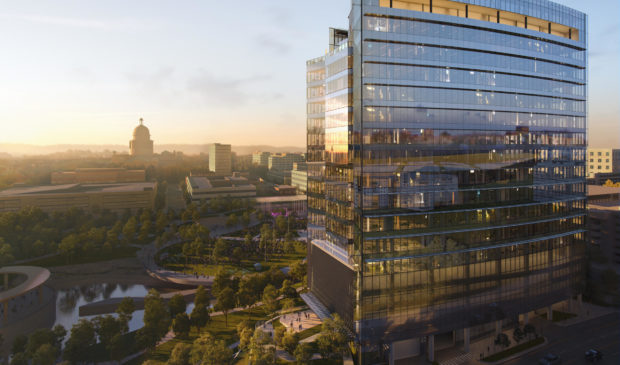Overlay district would spell out heights, uses for Central Health’s Brackenridge redevelopment
Wednesday, February 12, 2020 by
Chad Swiatecki Later this month City Council will consider a request to create an overlay district that will allow for the ambitious redevelopment of the former University Medical Center Brackenridge property owned by Central Health.
The public hearing expected to take place next week will allow comment on the change to the property that has long been zoned P (Public), though no long-term development plan is in place.
Central Health named Baltimore-based Wexford Science & Technology as the master developer for the property in 2017, but that relationship was terminated in early 2018 after both sides agreed a master developer approach would take too long to begin generating lease revenue from the site. As a result of the termination, the development plan that had been created for the 14.3-acre tract is no longer under consideration.
The hospital closed in 2017 after the opening of the Dell Seton Medical Center. The parcel the vacant building sits on is seen as one of the centerpieces for downtown’s long-coming health care innovation district that’s anchored by the nearby Dell Medical School at the University of Texas.
The hospital tower will gradually be torn down over the next eight months and construction work is ongoing on a 16-story building located on a 1.2-acre portion of the property that is being developed by the University of Texas’ 2033 Higher Education Development Foundation. Once completed in 2022, that building will also provide office space for the medical school and health care companies that are seen as the ideal new tenants throughout the district.
Ted Burton, Central Health’s vice president of communications, said a recently closed request for ideas on how to use the site brought six submissions from developers and consultants. He said there is no process in place to proceed with the ideas submitted and “neither a new master plan nor master developer are intended.”
Burton said the 2033 building was initiated as a way to quickly bring activity to the site and produce revenue. Currently the site’s prospects are being overseen by Steven Lamp, Central Health’s vice president of real estate and facilities.
The overlay, if granted by Council, would allow a floor area ratio of 25 to one, more than triple the eight to one allowed under standard central business district zoning.
The overlay would not require Central Health to participate in some of the normal community benefits that developers seeking higher density need to provide, though it has agreed to provide approximately 100 units of workforce housing in the finished mixed-use development.
Last month the Downtown Austin Alliance presented the results of a market study that said the curated approach to building the innovation district will increase property values in the area by 53 percent more than standard uncoordinated development.
Stephanie McDonald, vice president of enterprise alignment and coordination for Central Health and board president for Capital City Innovation, said local leaders see potential in combining Austin’s technology economy and the health care research that will be furthered at the medical school.
“(Health care) is one of the few areas where Austin actually doesn’t have a strong sector, but we think there’s every reason to believe, especially with attracting already Athenahealth and others into the area, that we should be a leader in life and biosciences and health care development,” she said. “We know there’s a strong entrepreneurial spirit and lots of people in Austin who are gravitating here because they want to be a part of what’s going on.”
McDonald said the specifics spelled into the overlay will make it clear to everyone interested in building or locating in the area that the city intends to make health care and life sciences a top priority.
“The overlay helps clarify what uses are permitted, the FAR that’s allowed, and makes everything a little bit clearer. It’s the first building of what we are considering the innovation district, so what Dell Medical is going to put into that campus is going to support innovation activities in the life and health sciences arena,” she said.
Jerry Rusthoven, assistant director of the Planning and Zoning Department, said the lack of capital view corridor height limits and the large building projects happening in other sections of downtown make the former Brackenridge site a natural spot for growth.
“I really think the northeastern quadrant of downtown is going to be the next hot spot for a while,” he said.
Rendering of one proposed building for the site by Gensler Architects.
The Austin Monitor’s work is made possible by donations from the community. Though our reporting covers donors from time to time, we are careful to keep business and editorial efforts separate while maintaining transparency. A complete list of donors is available here, and our code of ethics is explained here.
You're a community leader
And we’re honored you look to us for serious, in-depth news. You know a strong community needs local and dedicated watchdog reporting. We’re here for you and that won’t change. Now will you take the powerful next step and support our nonprofit news organization?




